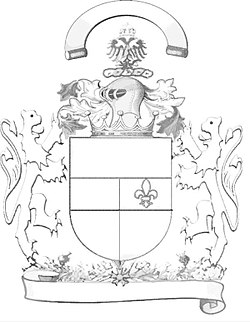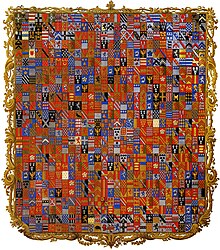Heraldic shield
The escutcheon is in the Heraldry one of the central partial pictorial arms .
view
A heraldic shield is always viewed from the point of view of the wearer, i.e. from behind, so that the left side on a figure is referred to as the right , often also as the front , since the shield was carried in the left hand and this side of the shield is thus the opponent was facing.
function
This shield is used to represent images of heralds and common figures and is differentiated by shape, size and color and the division into fields. It is only part of a coat of arms. It is assigned parts above, below and next to the sign. These parts are not required but are popular. These are the coat of arms , the shield holder and the gems .
position
The escutcheon is preferably aligned vertically with the central axis. That’s the rule. In exceptional cases, the sign can also be tilted (leaned). In special cases, however, the inclination must be emblazoned as a special feature . This applies to a certain extent to the marriage coat of arms (a special group of alliance coats of arms ). Heraldic shields are often referred to as being laid out , leaning against or tilted .
A heraldic shield is emblazoned when it is leaning to the right or left. This position has been known from seals, funerary monuments and coins since the Middle Ages. Regardless of the incline, everything must be aligned with the shield axis, which is supposed to be perpendicular to the upper edge of the shield. This definition is particularly important for hatching in black and white mode. Heraldic figures or heraldic animals are also affected. The notion since the 18th century that the situation side is important (for example: legal situation for scholars) is unheraldic.
size
The size of the shield in relation to the upper coat of arms suggests the era (and country of origin) of the representation. The middle of the helmet is regarded as the middle of the coat of arms.
| sign | helmet | Crest | epoch |
|---|---|---|---|
| 2 | 1 | 1 | Early days |
| 6th | 5 | 4th | High Gothic |
| 5 | 4th | 6th | Renaissance |
| 8th | 3 | 5 | Rococo |
| 3 | 2 | 3 | Modern times |
shape
The shape of the shield also depends on the time and country. By far the most common form is the spade-shaped French shield . But there are also shapes such as oval, heart-shaped, round and shields designed with spear rest (see Tartsche ). There are also triangular or ornate shields from the Renaissance.
| Overview of common heraldic shield shapes | |
|---|---|
|
|
The almond-shaped shield ( Norman shield ) was developed in the 11th century as an adaptation to equestrian combat with an inlaid lance . He was supposed to protect the side of the knight facing the opponent. |
|
|
In the 12th century the upper rounding was flattened and the shield now had the shape of an inverted triangle (Gothic shape). The reason for this is likely to have been the helmet, which provided better face protection. |
|
|
In the course of the 13th and 14th centuries, the shields became smaller and the point shortened, so that the sides now have a strong curve. The reason for this is the further developed body armor, which made the shield increasingly superfluous, so that around 1375 it was superfluous as a rider's protective weapon (French shield) . |
|
|
During the 13th century, a special shape with a semicircular rounded tip that resembles a U developed in Spain. This shape, correspondingly known as the Spanish shield , enables a particularly good floor plan for the design. |
|
|
In the 14th and 15th centuries, the rectangular tartsche appeared as a tournament shield , with a deep cutout, the spear rest, on the right side. |
|
|
In the 15th century, the jagged and curled edges gave the tartsche an appearance that later influenced the cartouches of the Baroque and Rococo (Baroque shield) . |
|
|
The Renaissance round shield of the 16th century was reintroduced based on shields from ancient times. It can be found as a lady's shield. |
|
|
The horse's front shield is a shield shape that mimics the forehead or head protection of a horse. It only appears in Italian heraldry. |
|
|
The diamond shield was invented for women because the heralds considered it improper for a woman to wield a war shield . It is mainly used in English heraldry. |
Further heraldic shield forms:
In modern times, the pointed oval Masai shield , named after the Maasai people , has come into use for many coats of arms in Africa. Examples are the coats of arms of Botswana , Kenya , Uganda and Tanzania .
colour
The coloring follows the heraldic principles and is called tinging . The color is real color or, in special cases, by hatching and dotting in black and white. In the beginning there were abbreviations of color written in the figures and fields, often using the Latin name.
Division of the shield
By division or splitting , the shield is divided into fields which, according to agreement, have a special name and thus play an important role in the blazon. The heraldic cuts , the formations of the dividing lines, are also included in the division and division in Heroldsbild .
In principle, the shield is divided into 9 positions , the square , with the heart in the middle - a small shield at this point is called the heart shield - and special names for the different areas. The shield division follows these lines in simple herald images . Grafting is called a gusset or a point inserted in the middle between the lower fields (mostly for coats of arms added later).
|
|
Division into nine fields |
|
|
Division into four fields ( crossing ) with heart sign |
|
|
Diagonal division from the left (top right to bottom left would be the normal case, which is not emblazoned) |
|
|
Lace cut |
Shield in shield
In heraldry , smaller coats of arms are placed on the main shield in order to achieve certain honors or statements. If other shields are in place, the main shield is also known as the back shield . The following options are used:
- Representation of the coat of arms, the main shield.
- The main shield is covered with a central shield
- in addition, the middle shield can be covered with the
- Mercy shield or honor shield on the head of the shield
- Heart shield for the coat of arms center position and
- Umbilical shield for the coat of arms placed in the base of the shield. The shield is on the navel point .
- either in the center of the coat of arms of one or
- placed in different numbers over the main shield in an orderly position.
Blazon of the shield
If there are several motifs, they are described in the blazon from right (from the point of view of the wearer) to left and from top to bottom so that the position no longer has to be specified. Animal figures are mostly shown looking forward / to the right, so that the direction is only indicated in the other case.
Heraldic shield in philately
Heraldic shields were also often used as stamp motifs. For example, in Austria's first stamp series - the so-called coat of arms issue in 1850 - coats of arms were used as symbols.
literature
Web links
Individual evidence
- ↑ Gert Oswald : Lexicon of Heraldry . Bibliographisches Institut, Leipzig 1984, p. 150.



